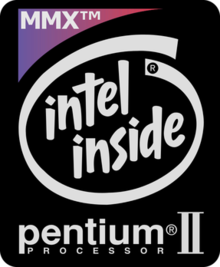
Back بنتيوم 2 Arabic Pentium II Catalan Pentium II Czech Pentium II Danish Intel Pentium II German Intel Pentium II Greek Pentium II Spanish Pentium II Estonian Intel Pentium II Finnish Pentium II French
 Original Pentium II MMX Case Badge | |
| General information | |
|---|---|
| Launched | May 7, 1997 |
| Discontinued | December 26, 2003[1] |
| Marketed by | Intel |
| Designed by | Intel |
| Common manufacturer |
|
| CPUID code | Klamath: 80522 Deschutes and Tonga: 80523 Dixon: 80524 |
| Performance | |
| Max. CPU clock rate | 233 MHz to 450 MHz |
| FSB speeds | 66 MT/s to 100 MT/s |
| Cache | |
| L1 cache | 32 KB (16 KB data + 16 KB instructions) |
| L2 cache | 256 KB - 512 KB |
| Architecture and classification | |
| Technology node | 350 nm to 180 nm |
| Microarchitecture | P6 |
| Instruction set | IA-32 |
| Extensions | |
| Physical specifications | |
| Transistors |
|
| Cores |
|
| Sockets |
|
| Products, models, variants | |
| Core names |
|
| History | |
| Predecessors | Pentium, Pentium Pro, Pentium MMX |
| Successors | Pentium III (SSE successor), Celeron, Pentium 4 (SSE2 successor) |
| Support status | |
| Unsupported | |

The Pentium II[2] brand refers to Intel's sixth-generation microarchitecture ("P6") and x86-compatible microprocessors introduced on May 7, 1997. Containing 7.5 million transistors (27.4 million in the case of the mobile Dixon with 256 KB on-die L2 cache), the Pentium II featured an improved version of the first P6-generation core of the Pentium Pro, which contained 5.5 million transistors. However, its L2 cache subsystem was a downgrade when compared to the Pentium Pro's.
In 1998, Intel stratified the Pentium II family by releasing the Pentium II-based Celeron line of processors for low-end computers and the Pentium II Xeon line for servers and workstations. The Celeron was characterized by a reduced or omitted (in some cases present but disabled) on-die full-speed L2 cache and a 66 MT/s FSB. The Xeon was characterized by a range of full-speed L2 cache (from 512 KB to 2048 KB), a 100 MT/s FSB, a different physical interface (Slot 2), and support for symmetric multiprocessing.
In February 1999, the Pentium II was replaced by the nearly identical Pentium III, which only added the then-new SSE instruction set. However, the older family would continue to be produced until June 2001 for desktop units,[3] September 2001 for mobile units,[4] and the end of 2003 for embedded devices.[1]
- ^ a b "Product Change Notification #102659-02" (PDF). Intel. August 14, 2002. Archived from the original (PDF) on March 20, 2003. Retrieved October 14, 2019.
- ^ "Microprocessor Hall of Fame". Intel. Archived from the original on July 6, 2007. Retrieved August 11, 2007.
- ^ "Product Change Notification #896" (PDF). Intel. January 14, 2000. Archived from the original (PDF) on September 30, 2000. Retrieved October 14, 2019.
- ^ "Product Change Notification #954" (PDF). Intel. March 13, 2000. Archived from the original (PDF) on August 15, 2000. Retrieved October 14, 2019.
© MMXXIII Rich X Search. We shall prevail. All rights reserved. Rich X Search